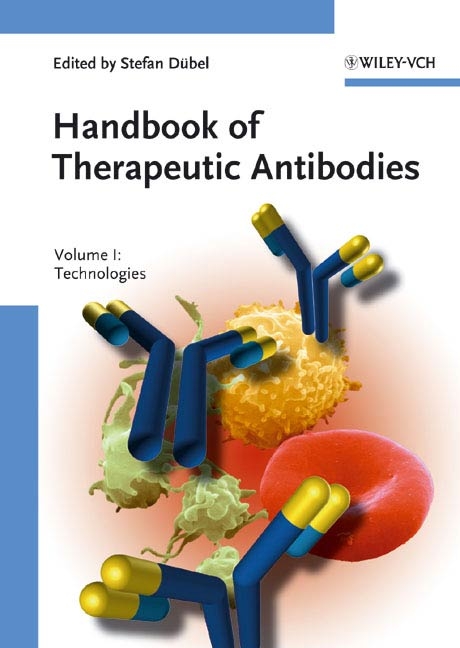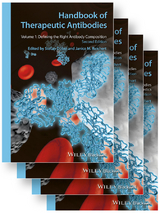
Handbook of Therapeutic Antibodies
Wiley-VCH (Verlag)
978-3-527-31453-9 (ISBN)
- Titel erscheint in neuer Auflage
- Artikel merken
A must-have resource for academic researchers, decision makers in industry and healthcare professionals in the clinic.
Stefan Dübel got his PhD at the Center for Molecular Biology Heidelberg (ZMBH) and spent his post-doc at the German Cancer Research Center (DKFZ) with research on the development of antibody display libraries. In the following years, he substantially participated in the invention of recombinant antibody phage display technology, as well as other recombinant antibody technologies and the development of various antibody fusion proteins. In 1996, he moved to the University of Heidelberg to establish the antibody engineering group at the Institute of Molecular Genetics. After holding a group leader position at the University of Heidelberg from 1996, Stefan Dübel went to the Biological Faculty of the Technical University of Braunschweig as a full professor in 2002. Here, he currently serves as head of the Department of Biotechnology in Braunschweig and managing director of the Institute of Biochemistry and Biotechnology. He has co-authored more than 90 scientific papers, 17 patents, as well as two acknowledged textbooks in the field of recombinant antibodies. He is also board member of scientific journals and the biotech industry.
Volume I: Technologies
Foreword
A Greeting from the Editor
PART 0: INTRODUCTION
Therapeutic Antibodies - From Past to Future
PART I: SELECTING AND SHAPING THE ANTIBODY MOLECULE
Selection strategies I: Monoclonal Antibodies
Selection strategies II: Antibody Phage Display
Selection strategies III: Transgenic Mice
Bioinformatic Tools for Antibody Engineering
Molecular Engineering I: Humanization
Molecular Engineering II: Affinity Maturation
Molecular Engineering III: Fc Engineering
PART II: THE WAY INTO THE CLINIC
Production and Downstream Processing
Pharmaceutical Formulation and Clinical Application
Immunogenicity of Antibody Therapeutics
Regulatory Considerations
Intellectual Property Issues
Volume II: Emerging Developments
PART III: BEYOND IGG: MODIFIED ANTIBODIES
Immunoscintigraphy and Radioimmunotherapy
Bispecific Antibodies
Immunotoxins / Targeted RNases
PART IV: EMERGING CONCEPTS
Automation of Selection and Engineering
Emerging Technologies for Antibody Selection
Emerging Alternative Production Systems
Non-Antibody Scaffolds
Emerging Therapeutic Concepts I: ADEPT
Emerging Therapeutic Concepts II: Nanotechnology
Emerging Therapeutic Concepts III:Cell-bound antibodies
Emerging Therapeutic Concepts IV:Anti-idiotypic Antibodies
PART V: ONGOING CLINICAL STUDIES:
Antibodies in Phase I/II/III: Cancer Therapy
Antibodies in Phase I/II/III: Targeting TNF
VOLUME III: APPROVED THERAPEUTICS
Adalimumab (Humira)
Alemtuzumab (Mabcampath)
Bevacizumab (Avastin)
Cetuximab (Erbitux)
Efalizumab (Raptiva)
Fanolesomab/Technetium99m (Neutrospec)
Gemtuzumab Ozogamicin (Mylotarg)
Infliximab (Remicade)
Muromonab (Orthoclone)
Natalizumab (Tysabri)
Omalizumab (Xolair)
Palivizumab (Synagis)
Rituximab (Rituxan)
Trastuzumab (Herceptin)
Overview: Abciximab, Arcitumomab, Basiliximab, Capromab, Cotara, Daclizumab, Edrecolomab, Ibritumomab, Igovomab, Nofetumomab, Satumomab, Sulesomab, Tositumomab and Votumumab
| Sprache | englisch |
|---|---|
| Maße | 170 x 240 mm |
| Gewicht | 2820 g |
| Einbandart | gebunden |
| Themenwelt | Naturwissenschaften ► Biologie ► Mikrobiologie / Immunologie |
| Technik ► Umwelttechnik / Biotechnologie | |
| Schlagworte | Antikörper • Biotechnologie |
| ISBN-10 | 3-527-31453-9 / 3527314539 |
| ISBN-13 | 978-3-527-31453-9 / 9783527314539 |
| Zustand | Neuware |
| Haben Sie eine Frage zum Produkt? |
aus dem Bereich



